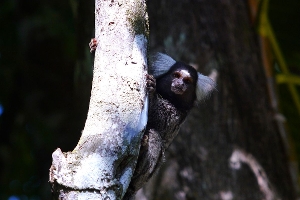Research project
Combination, variation and reproductive cues in vocalisations of the common marmoset (Callithrix jacchus)
How do common marmosets combine their calls into sequences and how are their vocalisations influenced by reproductive state?
- Duration
- 2014 - 2020
- Funding
- Research Grant from Lucie Burgers Foundation, The Netherlands
-
 PhD Fellowship from Evangelisches Studienwerk Villigst, Germany
PhD Fellowship from Evangelisches Studienwerk Villigst, Germany
-
 Research Grant from Dr. J.L. Dobberke Foundation, The Netherlands
Research Grant from Dr. J.L. Dobberke Foundation, The Netherlands
-
 Research Grant from Leakey Foundation, USA
Research Grant from Leakey Foundation, USA
- Partners
Prof. Dr. Antonio da Silva Souto, Lab of Ethology, Federal University of Pernambuco
Prof. Dr. Nicola Schiel, Laboratório de Etologia Teórica e Aplicada, Universidade Federal Rural de Pernambuco
Prof. Dr. José Geraldo de Vasconcelos Baracuhy, Baracuhy Biological Field Station, Caatinga region, Paraíba

Animal vocal communication & human language
Why are we the only species that has language and how did it evolve? One hypothesis is that human language could evolve on the basis of our ape-like cognitive abilities and the cooperatively breeding social system of early humans. To test this hypothesis, we should investigate the communicative abilities of animals (apes, other primates, other mammals and vertebrates) living in different social systems. Among primates, only members of the family Callitrichidae, including tamarins and marmosets, adopt cooperative breeding strategies. These species should thus be the target of investigations into the biological origins of human language.
Combination of calls
One trait considered uniquely human is complex syntax – rules that govern the combination of call elements, e.g. grammar. This allows a speaker to transmit virtually unlimited information with a limited set of speaking sounds. Non-human primates are capable of combining calls into sequences but it is still unclear whether this can result in combining call meanings. This project investigates the call combination system of a cooperatively breeding primate, the common marmoset. Which rules underlie the combination of calls in common marmosets? How are they influenced by context and how do these rules affect the communicative meaning?
Variation within call types
An alternative but not mutually exclusive strategy to encode more information in a limited repertoire is subtle variation within call types. Recent studies in lar gibbons suggest that their main social call varies consistently with context and that sexual hormones influence the acoustic properties of song. Therefore, I will study the potential effects of female fertility state on the mainly given social calls in common marmosets, controlling for context.
Significance
Studying animal vocal communication can inform us about the evolution of traits that allowed human language to arise. Together with comparative studies in other species, this project will help us to disentangle the roles that phylogenetic effects (relatedness between species) and socio-ecological factors (such as social systems) might have played during the evolution of non-human animal communication systems and human language. Furthermore, the hormonal study has the potential to guide future research and conservation efforts of closely related species in the wild.
Material & Methods
I work with free-living common marmosets in Brazil and with a captive colony in the Netherlands. My methods include audio and video recordings during individual follows, used for spectro-temporal acoustic analyses and context analyses, as well as carefully designed playback experiments. Furthermore, I try to find a link between vocalisations and sexual hormones in females by collecting faecal samples and analysing them in the lab.
Photo credit: A. Souto
